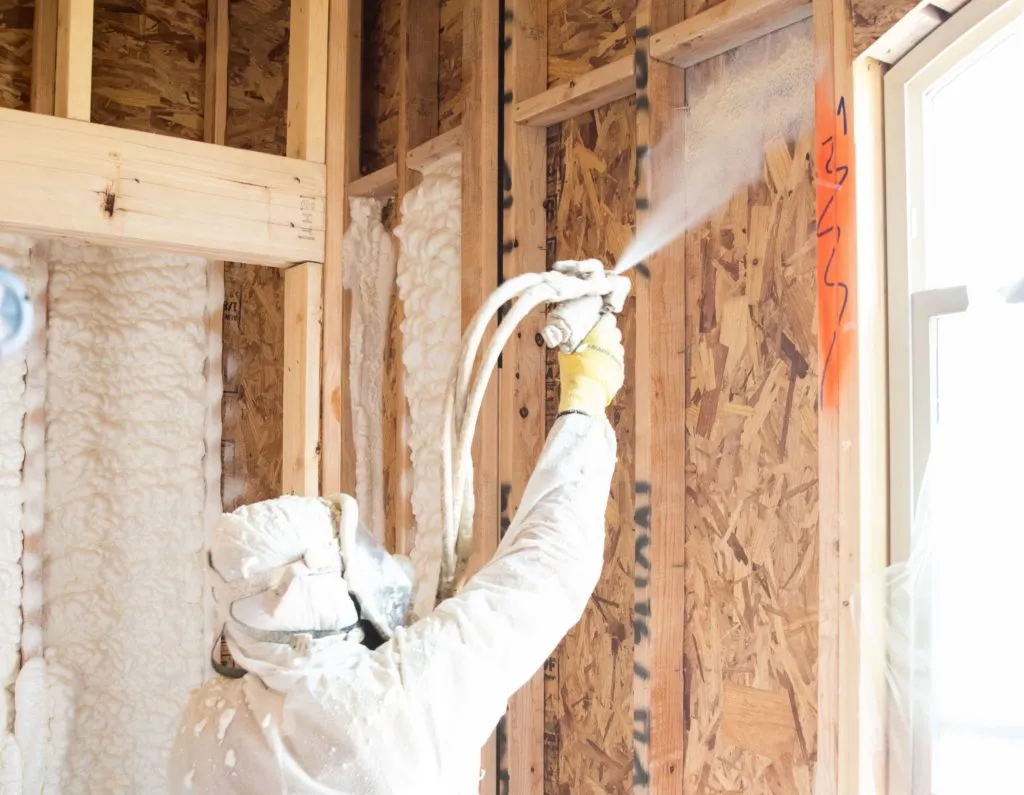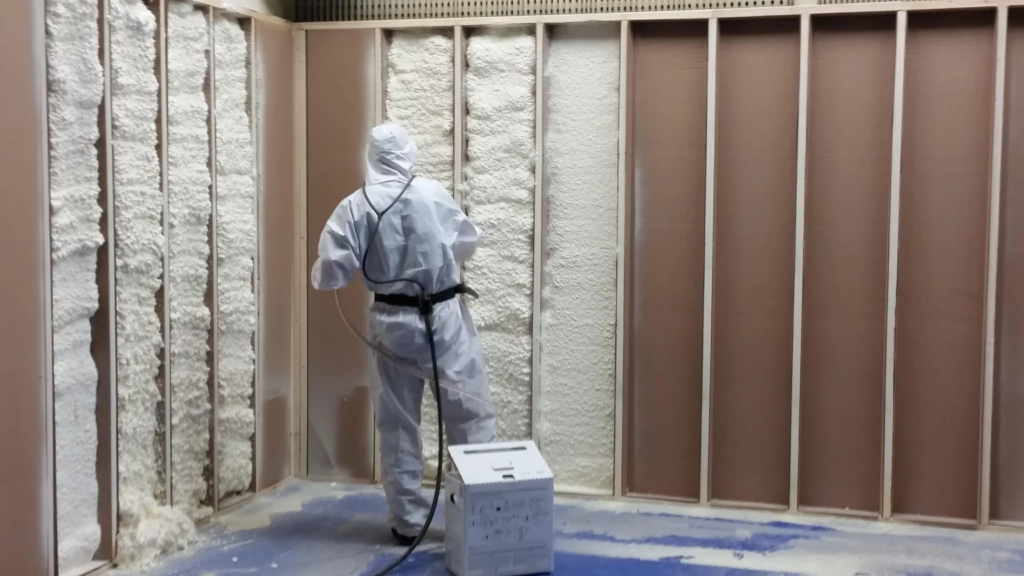Spray Foam’s Role in Continuous Insulation Across Exterior Wall Assemblies
Spray foam insulation serves as an optimal solution for continuous insulation in exterior wall assemblies by creating an uninterrupted thermal envelope that eliminates thermal bridging through framing members. With its ability to adhere to virtually any substrate and expand to fill irregular cavities, spray foam creates a seamless barrier that simultaneously functions as an air barrier, vapor retarder, and thermal insulation—three critical components that traditional insulation materials often require separate products to achieve.
Modern building codes increasingly emphasize continuous insulation requirements, and spray foam meets these demands by providing consistent R-values across the entire wall assembly. Unlike rigid board or batt insulation that leaves gaps at transitions, penetrations, and connections, spray foam creates a monolithic layer that maintains thermal performance integrity throughout the building envelope, reducing energy consumption by up to 40% compared to conventional insulation systems.
Continuous Insulation Performance Metrics
| Performance Factor | Closed-Cell Spray Foam | Open-Cell Spray Foam | Rigid Foam Board | Mineral Wool Board |
| R-value per inch | 6.0-7.0 | 3.6-3.9 | 4.0-6.5 | 3.0-4.3 |
| Air barrier capabilities | Excellent (Class II) | Excellent (Class III) | Poor (requires taping/sealing) | Poor (requires separate membrane) |
| Vapor permeance (1″ thickness) | 0.8-1.5 perms (Class II) | 5.0-15.0 perms (Class III) | 0.5-4.0 perms (varies by type) | 30+ perms (vapor open) |
| Thermal bridging mitigation | Complete | Complete | Partial (fasteners) | Partial (fasteners) |
| Water resistance | Excellent | Limited | Good (with proper joints) | Poor (requires WRB) |
| Joint/seam vulnerability | None (monolithic) | None (monolithic) | High (requires taping) | High (requires taping) |
| Installation complexity | Moderate (requires equipment) | Moderate (requires equipment) | High (many cuts/joints) | High (many cuts/joints) |
| Nominal thickness for R-20 | ~3 inches | ~5.5 inches | ~4-5 inches | ~5-6.5 inches |
Technical Specifications for Spray Foam in Exterior Wall Assemblies
| Property | Closed-Cell Spray Foam | Open-Cell Spray Foam | Application Considerations |
| Density | 1.75-2.5 lb/ft³ | 0.4-0.6 lb/ft³ | Higher density provides greater structural strength and moisture resistance |
| Compressive strength | 15-50 psi | <5 psi | Relevant for exterior applications with cladding attachment requirements |
| Water absorption | <4% by volume | >15% by volume | Critical factor in moisture-exposed applications |
| Dimensional stability | -0.1% to +1.0% | -0.5% to +2.0% | Important for long-term thermal performance maintenance |
| Temperature limits | -200°F to +200°F | -40°F to +180°F | Relevant for extreme climate applications |
| Fire performance | Class A (with coating) | Class A (with coating) | Building code requirement; may need intumescent coating |
| VOC content | Low after curing | Low after curing | Installation requires temporary ventilation protocols |
| Adhesion strength | 30-50 psi | 5-10 psi | Critical for long-term performance in exterior applications |
| Global warming potential | Varies by formulation | Low | Consider blowing agent environmental impact |
Continuous Insulation System Components
Exterior Wall Assembly Integration
Spray foam creates a comprehensive building envelope system when integrated with other critical components. The continuous insulation layer works in concert with weather-resistant barriers, cladding systems, and structural elements to create high-performance wall assemblies.
According to data from the Department of Energy, wall assemblies with spray foam continuous insulation typically reduce heating and cooling energy losses through the building envelope by 30-50% compared to traditional insulation methods that leave thermal bridges intact.
Bonus Tip: When designing continuous insulation systems with spray foam, coordinate with structural engineers early in the process to determine how cladding attachment will penetrate the insulation layer while minimizing thermal bridging.
Application Methods for Exterior Walls
Spray foam continuous insulation can be applied in various configurations depending on the wall assembly design and performance requirements:
- Interior application: Applied to the interior side of exterior sheathing, between framing members
- Exterior application: Applied directly to the exterior side of sheathing, creating a true thermal break
- Hybrid systems: Combining spray foam with other insulation types for cost-effective performance
The method selection depends on climate zone, wall assembly design, building type, and performance targets. Exterior applications provide the most complete thermal break but require special considerations for cladding attachment and weather protection during installation.
Building Science and Moisture Management
Vapor Control Strategies
Spray foam’s role in continuous insulation extends beyond thermal performance into critical moisture management functions. Closed-cell spray foam acts as an effective vapor retarder (Class II), controlling moisture diffusion through wall assemblies and reducing condensation risk within the building envelope.
Modern building science emphasizes the importance of integrated vapor and thermal control layers. According to ASHRAE research, approximately 80% of building envelope failures stem from moisture-related issues, making spray foam’s combined thermal and vapor control properties especially valuable.
Dew Point Control Within Wall Assemblies
Continuous spray foam insulation shifts dew point location within wall assemblies, preventing condensation on vulnerable structural components. This function is particularly important in cold climates where improper insulation strategies can lead to hidden moisture accumulation and structural degradation.
Bonus Tip: In mixed climates with both heating and cooling seasons, position the majority of the insulation value (about 2/3) on the predominantly cold side of the wall assembly to prevent seasonal condensation issues.

Things to Consider Before Making a Decision
Climate Zone Appropriateness
The appropriate spray foam type and wall assembly design varies significantly by climate zone:
| Climate Zone | Recommended Approach | Key Considerations |
| Zones 1-3 (Hot) | Vapor-open designs with attention to inward vapor drive | Resistance to high exterior moisture conditions |
| Zones 4-5 (Mixed) | Balanced vapor permeance with seasonal drying potential | Adaptability to both heating and cooling conditions |
| Zones 6-8 (Cold) | Interior vapor control with exterior insulation preferred | Prevention of cold-weather condensation within assemblies |
Existing Building Conditions
For retrofit applications, the condition of existing wall assemblies determines the appropriate continuous insulation strategy. Water damage, air leakage patterns, and structural issues must be addressed before encapsulation with spray foam.
Building age and historical significance may limit exterior insulation options and necessitate careful interior application approaches that preserve architectural features while improving thermal performance.
Code Compliance Requirements
Current energy codes mandate continuous insulation in most climate zones, with required R-values varying by location. The International Energy Conservation Code (IECC) and ASHRAE 90.1 specify minimum continuous insulation values that increase with climate zone severity.
Fire protection requirements must be addressed, particularly for spray foam materials, which typically require thermal barriers or ignition barriers depending on application location and building occupancy classification.
Common Questions About Spray Foam Continuous Insulation
Addressing Combustibility Concerns
While spray foam insulation is combustible in its raw form, properly installed systems with code-required thermal barriers present minimal fire safety risks. The International Building Code (IBC) provides specific requirements for protecting foam plastic insulation with approved thermal barriers, typically 1/2-inch gypsum board or equivalent materials that provide 15-minute fire resistance.
Building codes classify spray foam as a foam plastic insulation material requiring specific protection measures. When these requirements are followed, continuous insulation systems with spray foam can be safely implemented in virtually any building type.
Cladding Attachment Through Continuous Insulation
Attaching exterior cladding through thick layers of continuous insulation presents structural challenges that require specific solutions:
- Extended fasteners that penetrate through the insulation to structural members
- Engineered clip systems designed to minimize thermal bridging
- Strapping or furring strips installed with thermally broken fasteners
- Adhesive attachment systems for compatible cladding types
Each approach balances structural requirements with thermal performance goals. Engineering analysis may be required for thick continuous insulation systems to ensure cladding attachment meets wind load and structural requirements.
Spray Foam Continuous Insulation FAQ
How does spray foam continuous insulation compare to exterior insulation and finish systems (EIFS)?
While both provide continuous insulation, spray foam typically serves as part of a wall assembly rather than an all-in-one system like EIFS. Spray foam offers greater flexibility in cladding options and can achieve higher R-values per inch. EIFS integrates the cladding and insulation into one proprietary system with specific installation requirements. Spray foam allows designers to create custom wall assemblies with separate weather barriers and various cladding options.
Can spray foam continuous insulation eliminate the need for a weather-resistant barrier?
Closed-cell spray foam provides excellent bulk water resistance but is not a substitute for a dedicated weather-resistant barrier (WRB). Most building codes and manufacturers require a properly installed WRB behind cladding systems, even with closed-cell spray foam. The spray foam provides the thermal, air, and vapor control functions, while the WRB manages bulk water penetration through cladding joints and penetrations.
What are the acoustical benefits of spray foam continuous insulation?
Spray foam continuous insulation significantly reduces sound transmission through exterior walls. Open-cell foam typically provides better sound absorption (NRC values of 0.7-1.0) for airborne sound control, while closed-cell foam offers better mass for low-frequency sound attenuation. In urban environments or near highways, continuous wall spray foam insulation can reduce exterior noise penetration by 50-80% compared to traditional insulation methods.
How long does spray foam continuous insulation last in exterior wall applications?
Properly installed spray foam continuous insulation maintains its performance characteristics for the life of the building (50+ years) with no maintenance requirements. Unlike fibrous insulations that can settle or compress over time, spray foam maintains its original dimensions and R-value. Third-party testing has confirmed minimal degradation in thermal performance after decades of field exposure across various climate conditions.
What special considerations apply when retrofitting existing buildings with spray foam continuous insulation?
Existing buildings require careful assessment of wall assembly moisture conditions, structural integrity, and hazardous materials before installation. The retrofit strategy must address existing vapor barriers to prevent creating double vapor barrier conditions that trap moisture. Window and door openings typically require modification to accommodate the additional insulation thickness, and flashing details must be extended to maintain proper water management.

Make the Right Decision
Spray foam’s unique ability to provide continuous insulation while simultaneously addressing air leakage and moisture management makes it particularly valuable in high-performance building envelopes. The elimination of thermal bridging through structural elements can improve overall wall assembly thermal performance by 25-40% compared to cavity insulation alone, resulting in significant energy savings and improved occupant comfort.
When evaluating continuous insulation options, consider your specific climate requirements, building design parameters, and performance goals to determine the most appropriate spray foam application method and thickness. Proper integration with other building envelope components—particularly water management systems—remains essential for long-term performance and durability.
Raleigh Excel spray Foam
919 301-9435
Reviewer:
With nearly a decade in the spray foam insulation field, William Harris reviewed this post and provided guidance that reflects both technical understanding and real-world marketing experience.













